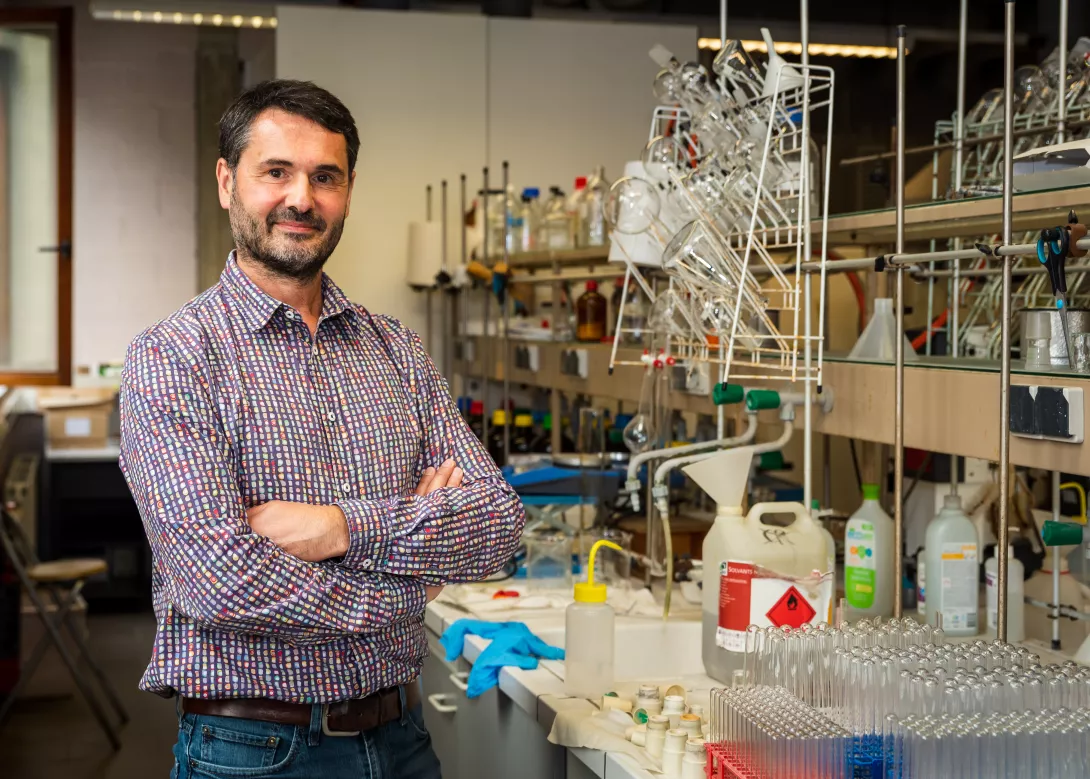
This article was produced for the "Eureka!" section of Omalius magazine #26 (September 2022)
This is the story of a young French violinist who was diverted from musicology by organic chemistry. "But not from music. In all the universities I attended, even during my two-year post-doc in the United States, in San Diego, I played in the local orchestras. And now I play chamber music..." The story of a researcher at the CNRS who made a "life choice", with his wife, by choosing Namur over Paris to raise their children. "It was not a simple decision, but it has been 18 years since we made it, and we do not regret it. And above all, the story of the collaboration between two scientists and their teams. "I am a chemist, which means that I design and manufacture molecules to try to answer, in the laboratory, questions that arise in the context of certain themes - my favourite subject being the chemistry of infectious diseases. In this context, I collaborate with a fellow biophysicist, David Alsteens, from UCLouvain, who is one of the world's leading specialists in the AFM (Atomic Force Microscopy) of viruses.
The magic of sugars
Stéphane Vincent and David Alsteens have been working together for five years. "We wondered whether it was possible to prevent a virus from entering the cell by opposing it with molecules that could bind to the virus's receptors. Initially, we opted for a reovirus that was particularly interesting because it has oncolytic properties and interacts with certain sugars. Contrary to the naive view that we may have, "and that I have as a chemist", a virus does not enter a cell by magic. Before it can enter, it has to attach itself to the cell.
When co-receptor rhymes with facilitator
And then SARS-CoV-2 appeared, and the two teams seized the virus by storm. "We knew that coronaviruses use a main receptor called ACE2, but that some human coronaviruses also target sugar co-receptors. As they had somehow got ahead of the game with their reovirus research, they decided in early 2020 to explore this alternative. "In addition to the main ACE2 receptor, which is the gateway through which the virus must pass to enter and infect a cell, we discovered that the virus uses a sugar as a co-receptor. Does this co-receptor play an essential role? "Essential, probably not, but a facilitator, without a doubt. In other words, if we prevent the virus from accessing this co-receptor, by making molecules that block its passage, we will slow it down, and therefore reduce the risk of infection.
Interactions
The two teams are already working on their third generation of molecules. With impressive results. "Obviously, we have only done in vitro tests. First with the famous Spike proteins of the virus, a kind of hook that allows SARS-CoV-2 to cling to the cell, then with the whole virus. In both cases, we demonstrated a strong interaction with our molecules - in particular one of them. Then we made a culture of lung cells and infected this culture with the virus. And again, we have evidence that our molecule, used in increasing concentrations, at least partially prevents the virus from entering.
In vivo
Having patented their results, Stéphane Vincent, David Alsteens and their colleagues published their first article this year in the journal Nature Communications. But it is at the next stage, in vivo tests, that the scientific community and especially the pharmaceutical industry are waiting for them. "Tests on mice are currently underway. The aim is to assess the level of infectivity depending on whether or not the mice are treated with our molecule. And if they are? "Our ambition is not to cure Covid. But, if we had, at the beginning of an infection - in a family, for example, when one of the members has a positive antigenic test - an antiviral spray, made from our molecules, we could help slow down the spread of the disease.
Drug?
Stéphane Vincent, however, refuses to give us false hope.
"Especially since, even if our molecules work in mice, they may not be effective in humans. But since it seems certain that we will have to live with this virus, a tool like this could help us. For him, who teaches his students that by choosing basic research they risk putting up a barrier of misunderstanding between themselves and their loved ones, however, the adventure is not without its charms. "For once, what I do is more or less understandable to my family. And even though I'm passionate about my usual research, this has another dimension: a direct link to everyday life.
Express CV
- 1994-1997: PhD in organic chemistry, Louis Pasteur University, Strasbourg (France). Supervisor: Dr Charles MIOSKOWSKI
- 1998-1999: Post-doctorate, The Scripps Research Institute, La Jolia (USA). Supervisor: Prof. Dr Chi-Huey WONG.
- 1999-2000: Post-doctorate, University Louis Pasteur, Strasbourg (France). Supervisor: Prof. Jean-Marie LEHN (Nobel Prize in Chemistry 1987).
- 2001-2004: Permanent researcher - CNRS, École Normale Supérieure, Paris.
- 2004: Professor (Lecturer) - Director of the Organic Chemistry Laboratory, UNamur.
- 2015 : Ordinary Professor - UNamur.
This article is taken from Omalius magazine #26 (September 2022).

